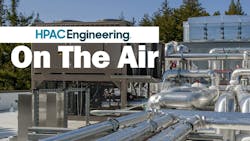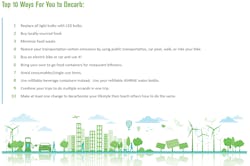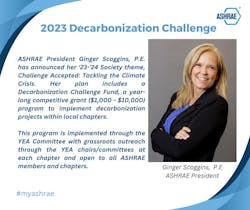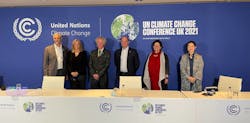HPAC 'On The Air': Climate Challenge Accepted, with Ginger Scoggins
In this episode, HPAC 'On The Air' welcomes back Ginger Scoggins, since June the new 2023-24 President of the American Society of Heating Refrigeration and Air-Conditioning Engineers, or ASHRAE.
A mechanical engineer, Ms. Scoggins is a principal at Engineered Designs Inc., in Cary, NC, and past chair of ASHRAE's Building Headquarters Ad Hoc Committee. She also led ASHRAE's delegation to the United Nations' COP26 Climate Change Conference in Glasgow in late 2021. She first appeared on this podcast early last year to help recap that event. Here, Ms. Scoggins describes ASHRAE's newly vital role on the world stage and the unavoidably compelling role that young engineers now seem destined to play.
Click to listen...
##########
What follows is an edited transcript of our conversation in early September...
##########
HPAC: Ginger, welcome back to HPAC 'On The Air.'
Ginger Scoggins: Thanks, Rob. Happy to be here.
HPAC: When you assumed ASHRAE's top slot in June, your inaugural speech set the theme for your presidential year with this title: 'Challenge Accepted, Tackling the Climate Crisis.' Please summarize for our listeners why you chose that theme and what steps you've already taken to make it a reality?
Ms. Scoggins: So, the whole purpose of that theme is to talk about the fact that ASHRAE is accepting the challenge of educating our members on how to address climate change. Buildings contribute close to 40% of all global greenhouse gas emissions. So that's not just operational carbon. That's embodied carbon lifecycle, carbon of buildings. So, our members need to get on board with the fact that decarbonization and electrification of buildings is what's going to be needed to address the climate crisis moving forward.
We've got tons of things in the works now to get our members on board and educated and ready to address this challenge. So, the whole purpose of the theme is to say that we're ready, and we're doing it.
HPAC: You talk about getting all members on board, but those members are everywhere. Could you just tell us a little bit about how your recent international experience with COP 26 and 27 has shaped your approach to this subject, now that you're leading an international organization? How do you spread the word so far and wide that all your members in chapters are, indeed, on board, as you say?
Ms. Scoggins: So, we have chapter conferences for all of our regions. We have 15 regions, and I've been recently to Region 14, which is Europe and Region 13, which is Asia. And this month, I'm going to South America. And then Sri Lanka, for our region-at-large, which has 30 chapters in multiple countries. So, we're trying to spread the word with all of the information ASHRAE has available to help our members.
As we know, most of the planet's coming growth is going to be in the Global South. The Global North is going to be fairly stagnant in terms of new buildings. It's mainly the renovation of existing buildings, that's the problem here. But in the South, with new buildings, getting them out of the gate to be designed with low- to zero carbon initiatives is the goal. Over 20% of our members are international, so trying to make sure that everybody knows what's available from ASHRAE to help them in this arena is the goal.
HPAC: Now, the work of ASHRAE's new Task Force on Decarbonization and the recent Epidemic Task Force has really put the Society on the frontlines of unprecedented current events. Never before has ASHRAE been in such a pivotal role of global influence at such a critical time. So how has the climate crisis and the pandemic changed the way ASHRAE approaches its work? Where once things may have seemed more academic, do you feel there is more daily urgency now? More gravitas, as it were?
Ms. Scoggins: Well, you are certainly right about that. I mean, who could have imagined that the two things that ASHRAE is most known for, which is indoor air quality and energy conservation, would come to a head with the pandemic and the climate crisis at almost the exact same time? But these are the areas where we shine. This is what our members do.
So, we're fortunate to have industry experts on both topics who can do what needs to be done to make sure that we address the issues, and we address them in a timely way. Yes, everything feels much more urgent. We are trying to operate at the speed of business and not the speed of ASHRAE, which in the past could have been a little bit slower than it needed to be. Looking at our new Standard 241 that came out for pathogen mitigation. That was quick. Roughly just four months from start to issuance. So, it was a very quick standard.
That is a record. Our new Whole Life Carbon Standard 240P also went from conception to public review in four months, but it takes some time to get those public review comments back. That's an ANSI standard, so it's a little bit more rigorous of a process. Standard 241 was not an ANSI standard yet, but the plan is to make it that way in the future.
HPAC: It strikes me that the last three ASHRAE presidents we have interviewed here, and now you, as well, all have come in at an especially compelling and vital time for our industry and the world, really. So, are you consulting with the prior presidents, to share insights and ideas on how to operate in what is essentially a period of extended crisis management?
Ms. Scoggins: Yes. Of course, every president in ASHRAE has a little bit different focus, but we still try to make these terms so that they kind of build on each other, so that we don't lose momentum from one to the next. You don't want to turn a ship in one direction, and then have the next person come in and turn it around in a different direction. Our goal is to continually have it turning in the right direction.
HPAC: With such compelling issues driving much of the Society's work, has that helped to inspire more input and enthusiasm from young engineers and newer members? I understand that has been priority for you, as well. Could you please speak a bit about the society's ongoing Diversity, Equity and Inclusion efforts and what other efforts are underway to reach out to young engineers of all backgrounds?
Ms. Scoggins: Yes, we're fortunate. We have a very, very strong Young Engineers in ASHRAE Committee. They're called the 'YEA Committee', and they are very passionate. One of my goals was to develop a 'Decarbonization Challenge' this year, and we turned that over to the YEA Committee and they developed the framework of the Challenge for our regions and our chapters.
That just went 'live' in August, where people can apply for a grant of up to $10,000 for a decarbonization effort in their area, and ASHRAE will consider supporting it. (Deadline for applying is November 30.)
As I said, young folks are so passionate. But if you just talk to them about designing HVAC equipment, they will yawn. If you talk to them about saving the planet, however, and climate change, and all of the difference they can make in the building services, building sciences area, that makes a big difference in getting them involved.
Regarding our D.E.I. effort, that is ongoing and it will always be ongoing. We have a D.E.I. subcommittee to the board of directors that is working on incorporating diversity, equity, and inclusion throughout all of our committees, and all of our chapters and regions. So, they're doing a really good job, I would say.
HPAC: Coming back for a moment to the Decarbonization Challenge and those grants, how many grants are available and how much money is involved?
Ms. Scoggins: They are available to all chapters in all regions, and we've allocated $50,000. So, applicants can win a grant, from $1,000 to $10,000, depending on what you're trying to do with your decarbonization project. So, we've got applications open on our website now and people are going to apply. The YEA committee will select the winners and then let people know at our Winter Conference in Chicago next January. Then, the winners will be able to report on what they've done at our annual meeting in Indianapolis next summer.
HPAC: Aside from the headline-grabbing work that we've already mentioned, what are some of the other work that ASHRAE is involved with right now that our readers might be interested in? What should we keep an eye out for in the months ahead?
Ms. Scoggins: Well, we have just recently taken over the MEP 2040 Challenge, which was launched by the Carbon Leadership Forum. It challenges engineers to design zero carbon buildings, (targeting) operational carbon by 2030, and embodied carbon by 2040. ASHRAE also just won a grant from the U.S. Dept. of Energy for almost $3 million, along with several partner organizations. As part of that, we have four states that we've partnered with to train the state inspectors on new energy codes and energy reduction. Of course, we also have a good delegation going to COP 28 in the United Arab Emirates at the end of November.
Before that, we also have our Decarbonization Conference coming in DC this October, which is big. And that's getting sold out, which is fantastic. Then next spring, we've got an international decarbonization conference planned for Madrid in April. That is still in the planning stages. There's just a lot going on, Rob.
HPAC: I'll say. Thanks so much for outlining all of that. My last question is really about time management. As a principal and founder of your own firm in North Carolina, how do you balance the time away from your business when you're in a top leadership role of a global society like this? And this is really a three-year commitment, from being president-elect to serving as past president next year. Could you tell us a little bit about that experience and how the reality so far may have differed from what you expected?
Ms. Scoggins: What's the saying? "If you want something done, give it to a busy person." So, it's good. I'm actually very fortunate that, at my business, I've got some good partners who are picking up my slack. Hopefully, they won't boot me out after this year. We'll see. But they're doing a great job, so I'm able to not be in the office as much.
Even so, with all the Zoom calls, like what we're doing here, and all the emails, and Wi-Fi everywhere, you can truly work from everywhere these days. So, I don't find that I miss a beat most of the time. Sometimes I do, but most of the times I don't. And now you can work on planes too, so you don't really ever get away from it.
HPAC: Yes, that reminds me of another turn of phrase I heard during the pandemic: "You're not working at home anymore. You're living at work."
Ms. Scoggins: That's right. You really can't disconnect anymore.
##########
To listen to previous 'HPAC On The Air' podcasts, please visit our Members Only page.
About the Author
Rob McManamy
Editor in Chief
An industry reporter and editor since 1987, McManamy joined HPAC Engineering in September 2017, after three years with BuiltWorlds.com, a Chicago-based media startup focused on tech innovation in the built environment. He has been covering design and construction issues for more than 30 years, having started at Engineering News-Record (ENR) in New York, before becoming its Midwest Bureau Chief in 1990. In 1998, McManamy was named Editor-in-Chief of Design-Build magazine, where he served for four years. He subsequently worked as an editor and freelance writer for Building Design + Construction and Public Works magazines.
A native of Bronx, NY, he is a graduate of both the University of Virginia, and The John Marshall Law School in Chicago.
Contact him at [email protected].




